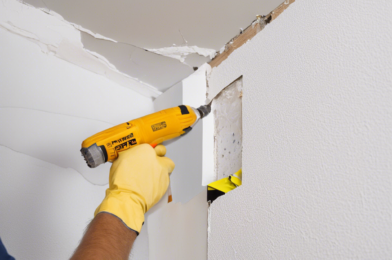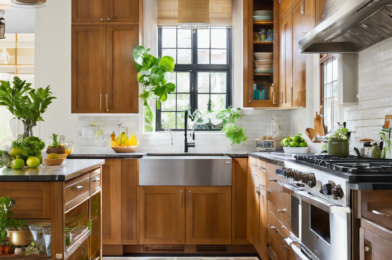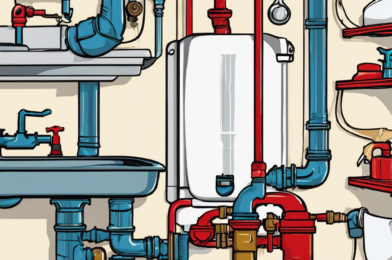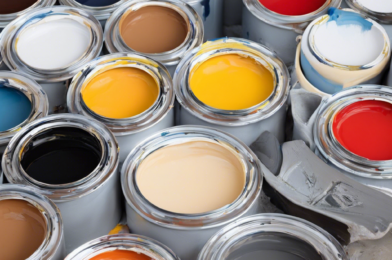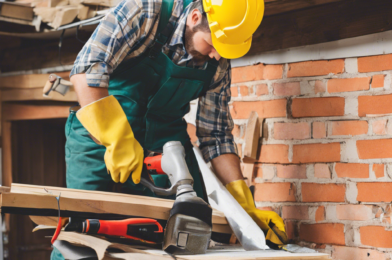Home repairs can be intimidating, especially if you’ve never wielded a hammer or operated a power drill before. However, many common household fixes are surprisingly simple and don’t require professional expertise. In this article, we’ll explore ten home repairs that you can tackle yourself, even with no prior experience. These DIY projects will not only save you money but also give you a sense of accomplishment and help you become more familiar with your home’s maintenance needs. From fixing a leaky faucet to patching drywall, these repairs cover a range of household issues that homeowners frequently encounter. By learning to handle these tasks yourself, you’ll gain valuable skills and the confidence to take on more complex projects in the future. So, roll up your sleeves, gather your tools, and get ready to become your own handyman. Remember, while these repairs are beginner-friendly, always prioritize safety and don’t hesitate to call a professional if you feel uncomfortable or encounter unexpected complications.
1. Fixing a Leaky Faucet
A dripping faucet is not just annoying; it can waste gallons of water and increase your utility bills. Fortunately, fixing a leaky faucet is a relatively simple task that most homeowners can handle. Start by turning off the water supply to the faucet. Then, remove the faucet handle by unscrewing it or prying off the decorative cap to access the screw underneath. Once the handle is off, you’ll see the stem assembly. The most common cause of leaks is worn-out washers or O-rings, which are easy to replace. Remove the old washer or O-ring and take it to your local hardware store to find an exact match. Replace the worn part, reassemble the faucet, and turn the water back on. If the leak persists, the issue might be with the valve seat or stem, which might require a bit more effort but is still manageable for a DIY enthusiast. Remember to keep track of the order in which you disassemble the parts to make reassembly easier. With a little patience and the right replacement parts, you can stop that annoying drip and save water in the process.
2. Unclogging a Drain
Clogged drains are a common household nuisance, but you don’t need to call a plumber every time your sink or tub is draining slowly. For minor clogs, start with a plunger. Ensure there’s enough water to cover the plunger’s head, create a tight seal around the drain, and plunge vigorously several times. If that doesn’t work, try a mixture of baking soda and vinegar. Pour about half a cup of baking soda down the drain, followed by half a cup of vinegar. Cover the drain with a plug or rag and wait 15 minutes before flushing with hot water. For more stubborn clogs, a plumber’s snake can be effective. Feed the snake into the drain until you feel resistance, then turn the handle to break up the clog. If you don’t have a snake, you can often achieve similar results with a straightened wire coat hanger. For bath and shower drains, hair is often the culprit. Remove the drain cover and use needle-nose pliers to pull out any visible hair clumps. Regular maintenance, like using a drain strainer and flushing drains with hot water weekly, can prevent future clogs. Remember, harsh chemical drain cleaners can damage your pipes, so it’s best to avoid them and stick to these gentler, more effective methods.
3. Patching Drywall
Small holes and dents in drywall are unsightly but easy to fix. For tiny nail holes, a dab of spackling compound applied with your finger is often sufficient. For slightly larger holes up to about 6 inches, you’ll need a patch. Start by cleaning the area around the hole and sanding it lightly. Cut a piece of self-adhesive mesh patch slightly larger than the hole and stick it over the damaged area. Use a putty knife to apply joint compound over the patch, feathering the edges to blend with the wall. Let it dry completely, then sand it smooth. Apply a second thin coat of compound if necessary, let it dry, and sand again until the patch is flush with the wall. For larger holes, you’ll need to cut out the damaged section in a square shape and insert a drywall patch. Secure the patch with drywall tape and joint compound, following the same process of applying, drying, and sanding until smooth. Once your patch is smooth and level with the surrounding wall, prime and paint the area to match. With practice, you’ll be able to make your walls look as good as new, erasing the evidence of past accidents or wall hangings.
4. Replacing a Toilet Flapper
If your toilet is constantly running or you hear phantom flushes, the culprit is likely a worn-out flapper. The good news is that replacing a toilet flapper is a quick and easy fix that can save you a significant amount on your water bill. Start by turning off the water supply to the toilet and flushing to empty the tank. Disconnect the chain from the flush lever and remove the old flapper. Take the old flapper to the hardware store to ensure you get an exact replacement. To install the new flapper, simply hook it onto the pegs at the base of the overflow tube and reattach the chain to the flush lever. Make sure the chain has a little slack when the flush lever is at rest. Turn the water back on and let the tank fill. Then, test the flush a few times to ensure the flapper is seating properly and creating a good seal. If you notice any leaks or if the toilet continues to run, adjust the chain length or the position of the flapper. This simple repair can typically be completed in less than 30 minutes and can significantly reduce water waste. Plus, you’ll no longer be bothered by the sound of your toilet randomly refilling throughout the day and night.
5. Fixing a Squeaky Door
A squeaky door can be incredibly annoying, but the fix is usually simple and requires no special skills. The most common cause of a squeaky door is friction in the hinges. Start by cleaning the hinges with a damp cloth to remove any built-up dirt or grime. Then, apply a lubricant to the hinge pins. You can use WD-40, silicone spray, or even cooking oil in a pinch. Spray or apply the lubricant generously, then open and close the door several times to work it into the hinge. Wipe away any excess lubricant to avoid drips. If the squeak persists, you may need to remove the hinge pins. To do this, close the door and tap out the pins from the bottom using a hammer and a nail. Clean the pins thoroughly, apply lubricant, and reinsert them. For wooden doors that are sticking rather than squeaking, the problem might be humidity causing the wood to swell. In this case, tightening the screws in the hinges or sanding down the edges of the door slightly can help. Remember to sand evenly and repaint the sanded area to protect the wood. With these simple techniques, you can silence those squeaky doors and enjoy peaceful, quiet movement throughout your home.
6. Replacing a Broken Tile
A cracked or chipped tile can be an eyesore and potentially lead to water damage if left unaddressed. Replacing a single tile is a manageable DIY project that can restore the look of your floor or wall. Begin by removing the grout around the damaged tile using a grout saw or oscillating multi-tool. Once the grout is removed, use a chisel and hammer to carefully break the tile into smaller pieces, being cautious not to damage surrounding tiles. Remove all the tile pieces and scrape off any remaining adhesive from the substrate. Clean the area thoroughly and let it dry. Apply tile adhesive to the back of the new tile using a notched trowel. Press the tile firmly into place, using tile spacers to ensure even gaps. Let the adhesive dry according to the manufacturer’s instructions. Once dry, remove the spacers and apply grout, forcing it into the gaps with a rubber float. Wipe away excess grout with a damp sponge. After the grout has set, buff away any haze with a dry cloth. This process requires patience and precision, but with care, you can achieve professional-looking results. Always wear safety glasses when breaking the old tile, and consider using knee pads if you’re working on a floor. With these steps, you can restore your tiled surface to its former glory without the expense of hiring a professional.
7. Installing a New Showerhead
Upgrading your showerhead is a simple way to improve your daily shower experience and potentially save water. Start by unscrewing the old showerhead by hand. If it’s stuck, use pliers with a cloth to protect the fixture’s finish. Once removed, clean any debris or old tape from the shower arm threads. Apply plumber’s tape to the threads, wrapping it clockwise 3-4 times. This helps create a watertight seal. Screw on the new showerhead by hand, being careful not to overtighten. If your new showerhead comes with a rubber washer, make sure it’s in place before installation. Once hand-tight, give it a quarter turn with pliers if needed, again using a cloth to protect the finish. Turn on the water to check for leaks. If you see any, tighten slightly or add more plumber’s tape. Some modern showerheads come with flow restrictors to save water. If you prefer a stronger flow, you can usually remove this restrictor following the manufacturer’s instructions. However, keep in mind that this will increase your water usage. With your new showerhead installed, you can enjoy improved water pressure, spray patterns, or even features like LED lights or Bluetooth speakers, depending on the model you choose. This simple upgrade can make your daily routine more enjoyable and efficient.
8. Fixing a Running Toilet
A running toilet can waste hundreds of gallons of water and significantly increase your water bill. The most common cause is a faulty flapper, which we covered earlier, but sometimes the issue lies with the fill valve. To diagnose the problem, remove the tank lid and flush. Watch to see if the water rises well above the overflow tube or if the fill valve never shuts off. If either of these occurs, you likely need to replace the fill valve. Start by turning off the water supply and flushing to empty the tank. Unscrew the water supply line from the fill valve. Remove the locknut under the tank that holds the fill valve in place and take out the old valve. Take it to the hardware store to find a matching replacement. Install the new fill valve by reversing the removal process. Adjust the height of the valve so the critical level mark (usually marked “CL” on the valve) is about an inch above the top of the overflow tube. Reattach the water supply line, turn the water back on, and let the tank fill. Adjust the float to stop the water about an inch below the top of the overflow tube. Flush a few times to ensure everything is working correctly. This repair can typically be completed in under an hour and can save you a significant amount on your water bill.
9. Sealing Gaps Around Windows and Doors
Drafty windows and doors can lead to higher energy bills and a less comfortable home. Fortunately, sealing these gaps is a straightforward DIY project. Start by inspecting your windows and doors on a windy day to identify where drafts are coming in. For small gaps, caulk is usually the best solution. Clean the area thoroughly and allow it to dry. Cut the tip of the caulk tube at a 45-degree angle and load it into a caulk gun. Apply the caulk in a smooth, continuous bead, filling the gap completely. Use a wet finger or caulk smoothing tool to create a neat finish. For larger gaps or spaces around door frames, foam weatherstripping is often more effective. Clean the surface and cut the weatherstripping to size. Peel off the backing and press it firmly into place, ensuring there are no gaps. For the bottom of doors, a door sweep can be installed to block drafts. These usually screw into place and have a flexible bottom that seals against the threshold. When sealing windows, be careful not to caulk them shut. Leave weep holes at the bottom of exterior windows uncovered to allow moisture to escape. By taking the time to seal gaps around your windows and doors, you can improve your home’s energy efficiency, reduce your utility bills, and create a more comfortable living environment.
10. Painting a Room
Painting is one of the most impactful and budget-friendly ways to transform a space, and it’s a project that most homeowners can tackle themselves. Start by preparing the room: remove all furniture or move it to the center and cover it with drop cloths. Remove switch plates and outlet covers, and use painter’s tape to protect trim, windows, and doors. Repair any holes or cracks in the walls with spackle, let it dry, and sand smooth. Clean the walls with a damp cloth to remove dust and let them dry completely. If you’re making a dramatic color change or painting over a dark color, apply a primer first. When you’re ready to paint, start with the edges using a brush, then use a roller for the main wall areas. Work in small sections, using a W or M pattern to distribute the paint evenly. Apply at least two coats for the best coverage, allowing each coat to dry completely before applying the next. For a professional-looking finish, remove the painter’s tape while the paint is still slightly wet to avoid peeling off any dried paint. Once everything is dry, reattach switch plates and outlet covers, and move furniture back into place. With patience and attention to detail, you can achieve a professional-looking paint job that completely refreshes your space. Remember to ventilate the room well during and after painting, and choose a low-VOC paint for a healthier indoor environment.

